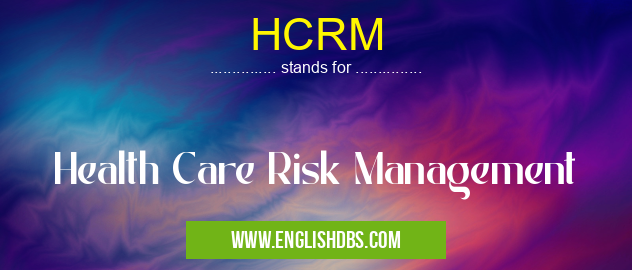What does HCRM mean in HEALTHCARE
HCRM is an essential component of modern healthcare delivery that promotes patient safety, protects healthcare professionals, and ensures the financial stability of healthcare organizations. By implementing comprehensive risk management strategies, healthcare organizations can create a safer and more efficient environment for patients and healthcare professionals alike.

HCRM meaning in Healthcare in Medical
HCRM mostly used in an acronym Healthcare in Category Medical that means Health Care Risk Management
Shorthand: HCRM,
Full Form: Health Care Risk Management
For more information of "Health Care Risk Management", see the section below.
» Medical » Healthcare
Key Elements of HCRM
- Patient Safety: Identifying and preventing patient harm through proactive measures such as medication safety protocols and infection control practices.
- Healthcare Professional Safety: Ensuring the well-being of healthcare professionals by managing occupational hazards, preventing workplace violence, and promoting self-care.
- Financial Risk Management: Protecting healthcare organizations from financial liabilities associated with adverse events, legal claims, and insurance costs.
- Quality Improvement: Continuously monitoring and improving healthcare processes to enhance patient outcomes and reduce risks.
- Regulatory Compliance: Adhering to applicable laws, regulations, and standards related to healthcare risk management.
Benefits of HCRM
- Improved Patient Safety: Reduced incidence of adverse events and improved patient outcomes.
- Enhanced Healthcare Professional Well-being: Protected healthcare professionals and reduced workplace hazards.
- Financial Stability for Healthcare Organizations: Minimized risks and liabilities, leading to reduced insurance costs and legal expenses.
- Quality Healthcare Delivery: Improved processes and reduced errors, resulting in better patient care.
- Compliance with Regulations: Adherence to industry standards and government regulations, ensuring legal protection and public trust.
Conclusion:
Essential Questions and Answers on Health Care Risk Management in "MEDICAL»HEALTHCARE"
What is the purpose of Health Care Risk Management (HCRM)?
HCRM is a systematic approach to identifying, assessing, and mitigating risks associated with providing health care services. It aims to protect patients, staff, and the organization from harm or loss.
What are the key elements of an effective HCRM program?
Effective HCRM programs typically include: risk identification, risk assessment, risk mitigation, risk monitoring, and risk reporting.
Who is responsible for HCRM within a healthcare organization?
HCRM is typically a multidisciplinary effort involving healthcare professionals, risk managers, compliance officers, and leadership at all levels of the organization.
What are some common risks in healthcare settings?
Common healthcare risks include patient safety incidents, medication errors, infections, workplace accidents, data breaches, and regulatory non-compliance.
How can HCRM improve patient safety?
HCRM helps identify and mitigate potential hazards that could lead to patient harm, such as falls, infections, and medication errors. It promotes a culture of safety and accountability, ultimately reducing the incidence of adverse events.
What are the benefits of HCRM for healthcare organizations?
HCRM can reduce liability, improve patient outcomes, enhance operational efficiency, and foster a positive work environment. It also supports compliance with regulatory requirements and industry standards.
What are some best practices for implementing an HCRM program?
Best practices include establishing clear roles and responsibilities, conducting regular risk assessments, developing and implementing risk mitigation plans, and monitoring and evaluating the program's effectiveness.
